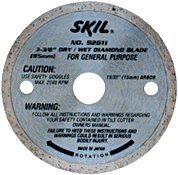Preparation
Once you have decided what floor you want to tile, determine what type of subfloor you'll be tiling. The subfloor is the actual surface you will be tiling on and is usually at least one surface layer below the current floor covering. The three main types of subfloor you may encounter are: Vinyl or linoleum, plywood, or concrete. Vinyl and plywood floors are most difficult to tile. Vinyl floors must be scarified or rough sanded to ensure your mortar will stick. Plywood floors are vulnerable to warping and are often times not completely level. Ideally, you will find a concrete subfloor to make laying tile as easy as possible. No matter what surface you find, you will need to thoroughly clean the floor of paint, adhesives, sealers or chemicals before starting.
Before you decide on tile options, estimate the size of the project by calculating the square footage of the room you intend to tile. Use your measurements to help decide on the best tile size option when you are shopping around. These measurements will give you a good idea of the number of tiles, as well as the amount of cement and grout you will need to cover your floor.
Next, you can begin deciding on the look for your room. Do you want an earth tone tile or a glossy, colored tile? Choose the tile that fits with the overall appeal of the room and flows with the adjacent rooms. The fun of DIY projects is the creativity involved so don't be afraid to try something different! Once you decide on the look you want to achieve, shop around for the most durable tiles you can find in your price range. The tiles you choose should deliver the aesthetic qualities you desire with the durability to withstand water absorption and constant use.
Tiling
Decide on the pattern you want to lay your tile in by drawing a diagram. You can lay tile in line with the walls of the room or at an angle, it all depends on your vision and how you imagine the room layout! Before you begin laying tile, make sure your surface is clean. Do your best to repair cracks and remove debris from the subfloor to ensure the mortar has the cleanest possible surface to adhere to.
Prepare your workspace by laying out all the tools you may need and mixing your mortar. Some tools you'll probably need are: buckets, trowels, floats and sponges, a tile saw (wet, dry, or both), a tile cutter, and possibly a driver for prep-work (you can read an in-depth article about these tools here!). Mix your mortar to a spreadable consistency that doesn't drip.
Begin laying tile in the center of your room by laying a small amount of mortar at a time. There is no need to be in a rush to lay tile; applying more mortar than you can cover before it sets will only create a mess and cost you more time to clean up. Starting in the center of the room helps create a uniform look as opposed to a skewed pattern that may arise if you begin from one side of the room. Also, this will give you time to get the hang of laying tile before you have to deal with cut pieces. As you lay tile, continually ensure that the pieces are level and there is sufficient space between each.
As you approach the edge of the room, you will need to make measurements for cutting. Take your time and be as accurate as possible so you don't waste tile and time. If you only need to cut a few pieces, a dry saw will typically work. However, for larger projects a wet saw is ideal to save time and make truer cuts. At this point you will have a good idea about what the final project will look like. The next step will be to grout and seal your tile work!
Grouting and Sealing
Once you have laid the final tile, let the work settle for a short period of time while you mix grout. Your grout should be wet and easy to spread. Begin by scraping your trowel over the grout and then spreading it throughout your tile work, filling all of the spacing between tiles. Remove excess grout with a wet sponge or rag.
Be sure to seal your grout work before it dries because it may become vulnerable to cracks and movement. You may as well have never spent all the time laying the tile if you don't seal your work! After sealing the tile and grout, clean the surface with damp rags or a mop.
Your first tile project is complete, stand back and admire your work! Generally, it is better to do your first few tile projects in smaller rooms to make the learning process easier. Also, don't hesitate to call a professional for help at any stage in the project. Sometimes it is best to get a pro's insight and opinion before you move too far.
Many DIYers have professional tile cutters cut their tile to ensure the correct angles are measured and cuts are made as cleanly as possible. Either way, the more tile projects you complete, the more comfortable you will become. Check in to Lets Blog Construction for tips on completing specific tile projects like backsplashes, mosaics, countertops, etc.
 |
Price :
|
Price : 

